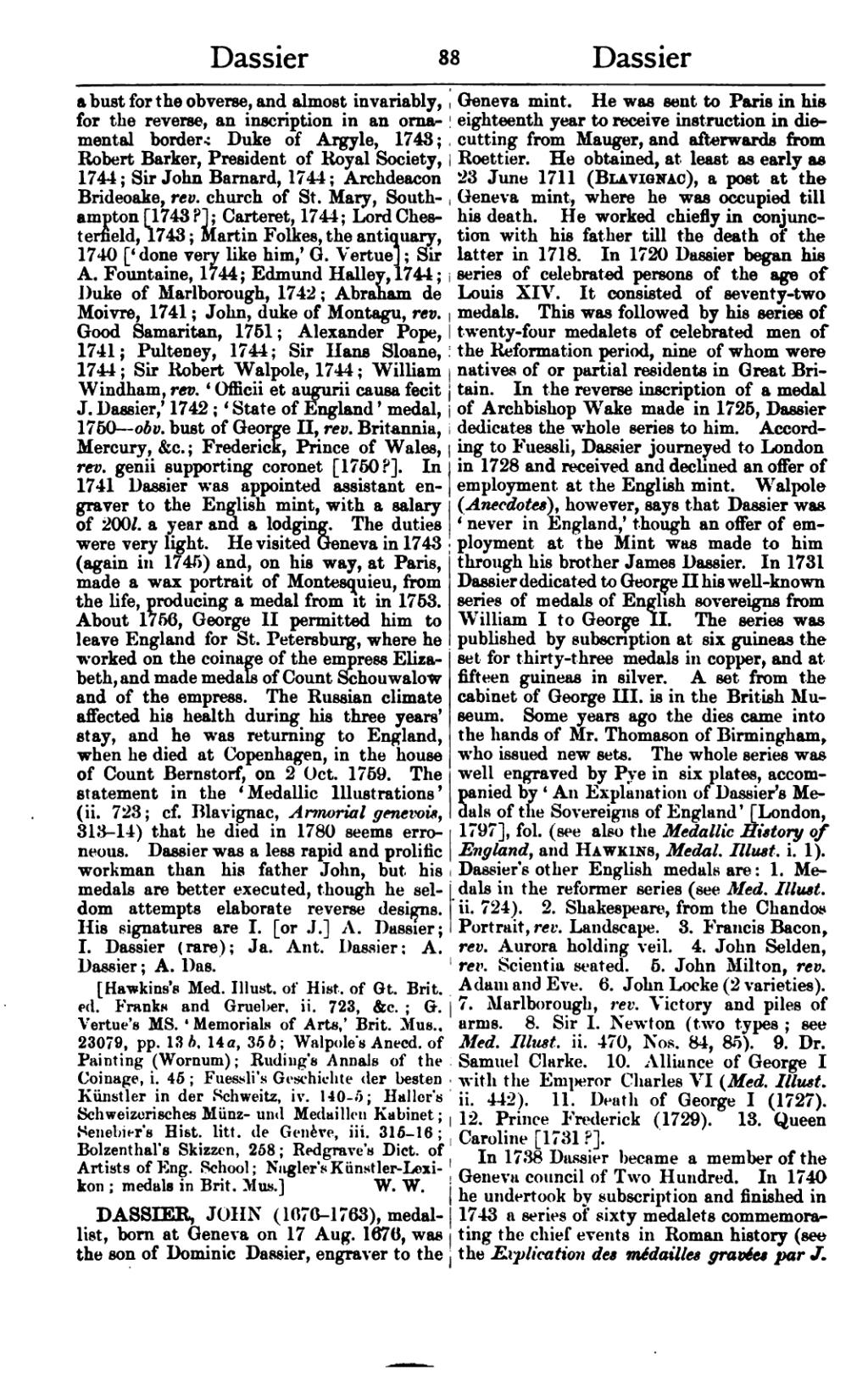a bust for the obverse, and almost invariably, for the reverse, an inscription in an ornamental border: Duke of Argyle, 1743; Robert Barker, President of Royal Society, 1744; Sir John Barnard, 1744; Archdeacon Brideoake, rev. church of St. Mary, Southampton [1743?]; Carteret, 1744; Lord Chesterfield, 1743; Martin Folkes, the antiquary, 1740 [‘done very like him,’ G. Vertue]; Sir A. Fountaine, 1744; Edmund Halley, 1744; Duke of Marlborough, 1742; Abraham de Moivre, 1741; John, duke of Montagu, rev. Good Samaritan, 1751; Alexander Pope, 1741; Pulteney, 1744; Sir Hans Sloane, 1744; Sir Robert Walpole, 1744; William Windham, rev. ‘Officii et augurii causa fecit J. Dassier,’ 1742; ‘State of England’ medal, 1750—obv. bust of George II, rev. Britannia, Mercury, &c.; Frederick, Prince of Wales, rev. genii supporting coronet [1750?]. In 1741 Dassier was appointed assistant engraver to the English mint, with a salary of 200l. a year and a lodging. The duties were very light. He visited Geneva in 1743 (again in 1745) and, on his way, at Paris, made a wax portrait of Montesquieu, from the life, producing a medal from it in 1753. About 1756, George II permitted him to leave England for St. Petersburg, where he worked on the coinage of the empress Elizabeth, and made medals of Count Schouwalow and of the empress. The Russian climate affected his health during his three years' stay, and he was returning to England, when he died at Copenhagen, in the house of Count Bernstorf, on 2 Oct. 1759. The statement in the ‘Medallic Illustrations’ (ii. 723; cf. Blavignac, Armorial genevois, 313–14) that he died in 1780 seems erroneous. Dassier was a less rapid and prolific workman than his father John, but his medals are better executed, though he seldom attempts elaborate reverse designs. His signatures are I. [or J.] A. Dassier; I. Dassier (rare); Ja. Ant. Dassier; A. Dassier; A. Das.
[Hawkins's Med. Illust. of Hist. of Gt. Brit. ed. Franks and Grueber, ii. 723, &c.; G. Vertue's MS. ‘Memorials of Arts,’ Brit. Mus., 23079, pp. 13 b, 14 a, 35 b; Walpole's Anecd. of Painting (Wornum); Ruding's Annals of the Coinage, i. 45; Fuessli's Geschichte der besten Künstler in der Schweitz, iv. 140–5; Haller's Schweizerisches Münz- und Medaillen Kabinet; Senebier's Hist. litt. de Genève, iii. 315–16; Bolzenthal's Skizzen, 258; Redgrave's Dict. of Artists of Eng. School; Nagler's Künstler-Lexikon; medals in Brit. Mus.]
DASSIER, JOHN (1676–1763), medallist, born at Geneva on 17 Aug. 1676, was the son of Dominic Dassier, engraver to the Geneva mint. He was sent to Paris in his eighteenth year to receive instruction in die-cutting from Mauger, and afterwards from Roettier. He obtained, at least as early as 23 June 1711 (Blavignac), a post at the Geneva mint, where he was occupied till his death. He worked chiefly in conjunction with his father till the death of the latter in 1718. In 1720 Dassier began his series of celebrated persons of the age of Louis XIV. It consisted of seventy-two medals. This was followed by his series of twenty-four medalets of celebrated men of the Reformation period, nine of whom were natives of or partial residents in Great Britain. In the reverse inscription of a medal of Archbishop Wake made in 1725, Dassier dedicates the whole series to him. According to Fuessli, Dassier journeyed to London in 1728 and received and declined an offer of employment at the English mint. Walpole (Anecdotes), however, says that Dassier was ‘never in England,’ though an offer of employment at the Mint was made to him through his brother James Dassier. In 1731 Dassier dedicated to George II his well-known series of medals of English sovereigns from William I to George II. The series was published by subscription at six guineas the set for thirty-three medals in copper, and at fifteen guineas in silver. A set from the cabinet of George III. is in the British Museum. Some years ago the dies came into the hands of Mr. Thomason of Birmingham, who issued new sets. The whole series was well engraved by Pye in six plates, accompanied by ‘An Explanation of Dassier's Medals of the Sovereigns of England’ [London, 1797], fol. (see also the Medallic History of England, and Hawkins, Medal. Illust. i. 1). Dassier's other English medals are: 1. Medals in the reformer series (see Med. Illust. ii. 724). 2. Shakespeare, from the Chandos Portrait, rev. Landscape. 3. Francis Bacon, rev. Aurora holding veil. 4. John Selden, rev. Scientia seated. 5. John Milton, rev. Adam and Eve. 6. John Locke (2 varieties). 7. Marlborough, rev. Victory and piles of arms. 8. Sir I. Newton (two types; see Med. Illust. ii. 470, Nos. 84, 85). 9. Dr. Samuel Clarke. 10. Alliance of George I with the Emperor Charles VI (Med. Illust. ii. 442). 11. Death of George I (1727). 12. Prince Frederick (1729). 13. Queen Caroline [1731?].
In 1738 Dassier became a member of the Geneva council of Two Hundred. In 1740 he undertook by subscription and finished in 1743 a series of sixty medalets commemorating the chief events in Roman history (see the Explication des médailles gravées par J.
